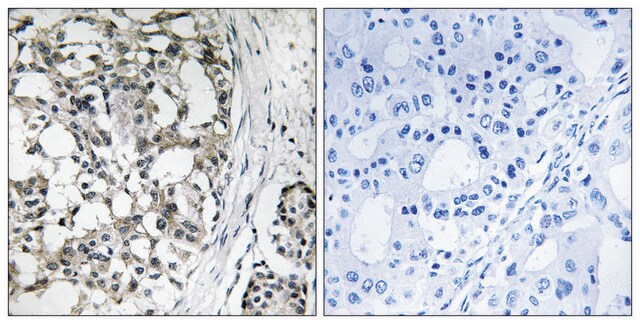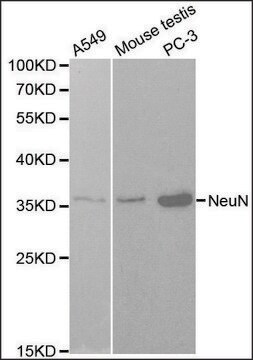ABC142
Anti-Pex14 (peroxisomal membrane marker) Antibody
serum, from rabbit
Synonim(y):
Peroxisomal membrane protein PEX14, PTS1 receptor-docking protein, Peroxin-14, Peroxisomal membrane anchor protein PEX14
About This Item
Polecane produkty
pochodzenie biologiczne
rabbit
Poziom jakości
forma przeciwciała
serum
rodzaj przeciwciała
primary antibodies
klon
polyclonal
reaktywność gatunkowa
mouse, rat, human
metody
immunocytochemistry: suitable
western blot: suitable
numer dostępu NCBI
numer dostępu UniProt
Warunki transportu
wet ice
docelowa modyfikacja potranslacyjna
unmodified
informacje o genach
human ... PEX14(5195)
Opis ogólny
Immunogen
Zastosowanie
Inflammation & Immunology
Inflammation & Autoimmune Mechanisms
Immunocytochemistry Analysis: A representative lot from an independent laboratory detected PEX14 (peroxisomal membrane marker) in Pex14p-transfected CHO cells (Pinto, M. P., et al. 2006. J Biol Chem. 281(45):34492-34502.).
Jakość
Western Blot Analysis: A 1:500 dilution from a representative lot detected PEX14 (peroxisomal membrane marker) in 10 µg of NIH/3T3 cell lysate.
Opis wartości docelowych
Postać fizyczna
Przechowywanie i stabilność
Handling Recommendations: Upon receipt and prior to removing the cap, centrifuge the vial and gently mix the solution. Aliquot into microcentrifuge tubes and store at -20°C. Avoid repeated freeze/thaw cycles, which may damage IgG and affect product performance.
Komentarz do analizy
NIH/3T3 cell lysate
Oświadczenie o zrzeczeniu się odpowiedzialności
Nie możesz znaleźć właściwego produktu?
Wypróbuj nasz Narzędzie selektora produktów.
Kod klasy składowania
10 - Combustible liquids
Klasa zagrożenia wodnego (WGK)
WGK 1
Certyfikaty analizy (CoA)
Poszukaj Certyfikaty analizy (CoA), wpisując numer partii/serii produktów. Numery serii i partii można znaleźć na etykiecie produktu po słowach „seria” lub „partia”.
Masz już ten produkt?
Dokumenty związane z niedawno zakupionymi produktami zostały zamieszczone w Bibliotece dokumentów.
Nasz zespół naukowców ma doświadczenie we wszystkich obszarach badań, w tym w naukach przyrodniczych, materiałoznawstwie, syntezie chemicznej, chromatografii, analityce i wielu innych dziedzinach.
Skontaktuj się z zespołem ds. pomocy technicznej








